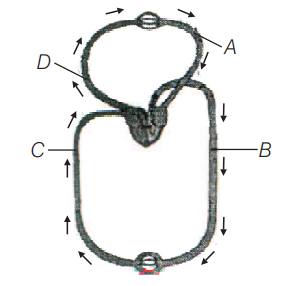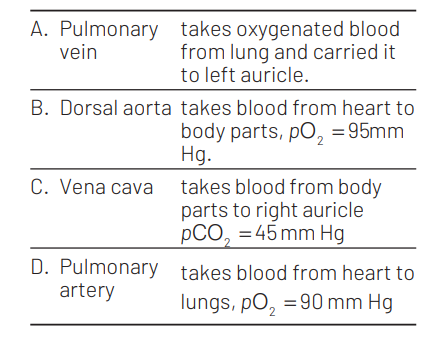Question
Blood pressure in the pulmonary artery is [NEET 2016, Phase I]
(a) more than that in the carotid
(b) more than that in the pulmonary vein
(c) less than that in the vena cava
(d) same as that in the aorta
Answer/Explanation
Ans. (b)
Blood pressure in different blood vessels : Artery $>$ Arteriole $>$ Capillary $>$ Venule $>$ Vein (vena cava). The pulmonary arteries have thicker smooth muscle and connective tissue then the pulmonary veins to accomodate the higher pressure and high rate of blood flow.
Question
In mammals, which blood vessel would normally carry largest amount of urea? [NEET 2016, Phase I]
(a) Dorsal Aorta
(b) Hepatic Vein
(c) Hepatic Portal Vein
(d) Renal Vein
Answer/Explanation
Ans. (b)
Urea is synthesised in liver. So, maximum amount of urea is present in hepatic vein and minimum in renal vein.
Question
Figure shows schematic plan of blood circulation in human with labels $A-D$. Identify the correct label with given function [NEET 2013]

(a) A-pulmonary vein-takes impure blood from body parts, $\mathrm{pO}_2=60 \mathrm{~mm} \mathrm{Hg}$
(b) B-pulmonary artery takes blood from heart to lungs, $\mathrm{pO}_2=90 \mathrm{~mm} \mathrm{Hg}$
(c) C-vena cava takes blood from body parts to right auricle, $\mathrm{pCO}_2=45 \mathrm{~mm} \mathrm{Hg}$
(d) D-dorsal aorta takes blood from heart to body parts, $\mathrm{pO}_2=95 \mathrm{~mm} \mathrm{Hg}$
Answer/Explanation
Ans. (c)
The correct labelling of parts with their respective functions is as follows.

Question
Arteries are best defined as the vessels which [CBSE AIPMT 2011]
(a) carry blood away from the heart to different organs
(b) break up into capillaries which reunite to form a vein
(c) carry blood from one visceral organ to another visceral organs
(d) supply oxygenated blood to the different organs
Answer/Explanation
Ans. (a)
Arteries are blood vessels that carry blood away from the heart towards different organs. They generally contain oxygenated blood (except pulmonary artery which contains deoxygenated blood). The blood flows in an artery under alternate increased pressure and with jerks.
Question
Which one of the following statements is correct regarding blood pressure? [CBSE AIPMT 2011]
(a) 100/55 $\mathrm{mm} \mathrm{Hg}$ is considered an ideal blood pressure
(b) 105/50 mm Hg makes one very active
(c) 190/110 $\mathrm{mm} \mathrm{Hg}$ may harm vital organs like brain and kidney
(d) $130 / 90 \mathrm{~mm} \mathrm{Hg}$ is considered high and requires treatment
Answer/Explanation
Ans. (c)
Blood pressure [ $190 / 110 \mathrm{~mm} \mathrm{Hg}$ ) of an individual is $140 / 90$ [ 140 over 90 ] or higher, it shows hypertension. High blood pressure [ $190 / 110 \mathrm{~mm} \mathrm{Hg}$ ) leads to heart diseases and also affects vital organs like brain and kidney. Hypertension means the blood pressure that is higher than normal [120/80] In this measurement, $120 \mathrm{~mm}$ $\mathrm{Hg}$ (millimeter af mercury pressure) is the normal systolic or pumping, pressure and $80 \mathrm{~mm} \mathrm{Hg}$ is the normal diastolic or resting pressure.
Question
Pulmonary artery is different from pulmonary vein because it has [CBSE AIPMT 2000]
(a) larger lumen
(b) thick muscular walls
(c) no endothelium
(d) valves
Answer/Explanation
Ans. (b)
Arteries have thick walls, narrow lumen but no valves. Endothelium is present in both arteries and veins.
Question
The thickening of walls of arteries is called [CBSE AIPMT 1999]
(a) arthritis
(b) atherosclerosis
(c) anaeurysm
(d) Both(a) and (c)
Answer/Explanation
Ans. (b)
Atherosclerosis invalves thickening of inner walls of arteries due to deposition of lipid(cholesteral) which prevents the dilation of arteries.
Question
An adult human with average health has systolic and diastolic pressures as [CBSE AIPMT 1998]
(a) $80 \mathrm{~mm} \mathrm{Hg}$ and $80 \mathrm{~mm} \mathrm{Hg}$
(b) $70 \mathrm{~mm} \mathrm{Hg}$ and $120 \mathrm{~mm} \mathrm{Hg}$
(c) $120 \mathrm{~mm} \mathrm{Hg}$ and $80 \mathrm{~mm} \mathrm{Hg}$
(d) $50 \mathrm{~mm} \mathrm{Hg}$ and $80 \mathrm{~mm} \mathrm{Hg}$
Answer/Explanation
Ans. (c)
In a normal human being, the systolic and diastolic pressure are $120 \mathrm{mmHg}$ and $80 \mathrm{mmHg}$ respectively.
Question
Closed circulatory system occurs in [CBSE AIPMT 1994]
(a) cockroach
(b) tadpole/fish
(c) mosquito
(d) house fly
Answer/Explanation
Ans. (b)
Closed circulatory system is usually high pressure system, in which blood flows in closed tubular structures called blood vessels (arteries, veins and capillaries). It is found in most of annelids,
cephalopods, among the molluscs and all vertebrates including human beings. In this type of system there is no direct contact between body tissues and blood. This is more efficient as blood circulation is completed in shart period.
Question
Wall of blood capillary is formed of [CBSE AIPMT 1993, 91]
(a) haemocytes
(b) parietal cells
(c) endothelial cells
(d) oxyntic cells
Answer/Explanation
Ans. (c)
Each capillary is lined by a single layer of flat cells, called endothelium. The endothelium allows the exchange of materials like the nutrients, respiratory gases, waste products, hormones, etc between the blood and surrounding tissue cells through the tissue fluid.
Question
Splenic artery arises from [CBSE AIPMT 1990]
(a) anterior mesenteric artery
(b) coeliac artery (or celiac artery)
(c) posterior mesenteric artery
(d) intestinal artery
Answer/Explanation
Ans. (b)
Splenic artery is the blood vessel that supplies oxygenated blood to the spleen. It branches from the celiac artery and follows a course superior to the pancreas.
Question
A vein possesses a large lumen because [CBSE AIPMT 1990]
(a) tunica media and tunica externa form a single coat
(b) tunica interna and tunica media form a single coat
(c) tunica interna, tunica media and tunica externa are thin
(d) tunica media is a thin coat
Answer/Explanation
Ans. (d)
The tunica media is comparatively thin in the veins making a large lumen in veins. Basically each artery and vein consists of three layers, an inner lining of squamous endothelium, the tunica interna, a middle layer of smooth muscle and elastic fibre, the tunica media and an external layer of fibrous connective tissue with collagen fibres, the tunica externa.
Question
Arteries carry oxygenated blood except [CBSE AIPMT 1989]
(a) pulmonary
(b) cardiac
(c) hepatic
(d) systemic
Answer/Explanation
Ans. (a)
Right ventricle pumps deoxygenated blood into pulmonary artery which supplies it to the lungs where oxygenation of blood takes place.
